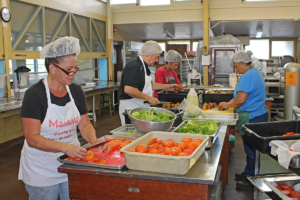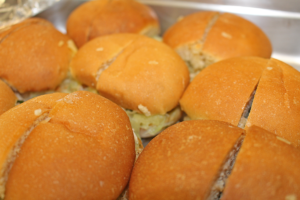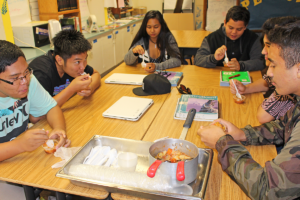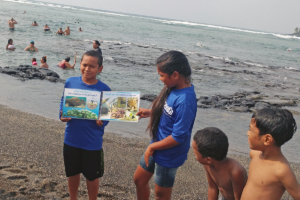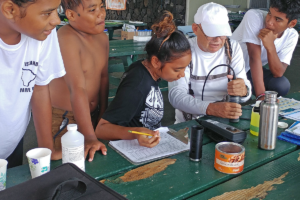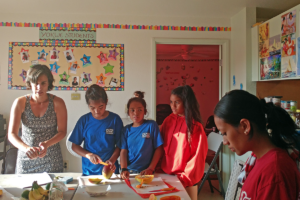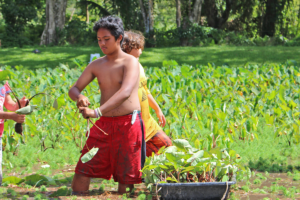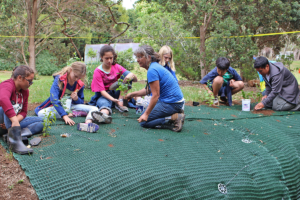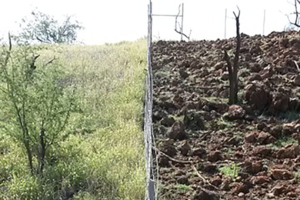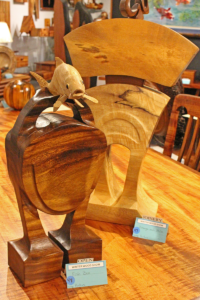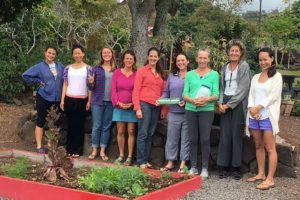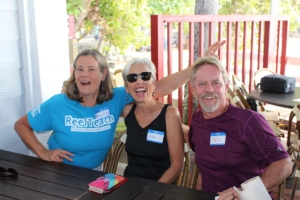
Kohala leads the way to more local food in Hawai‘i’s schools
All of Hawai‘i’s 283 K through 12 public and charter schools belong to a single school district, making it one of the largest in the United States. Given that Hawai‘i imports nearly 85% of its food, procuring a consistent and abundant supply of fresh, locally grown ingredients for the entire district is nearly impossible. Three schools in Kohala are evaluating a more localized recipe development and food procurement model that has the potential to change school food—and childhood nutrition—in Hawai‘i for the better.
Chef Greg Christian (second from left) and cafeteria staff make 800 meals a day for the students of Kohala Elementary, Middle, and High Schools
Lieutenant Governor Shan Tsutsui currently leads the Hawai‘i Farm to School Initiative in collaboration with Hawaii Department of Agriculture (HDOA), the Hawaii State Department of Education (HIDOE), the State Procurement Office, and The Kohala Center. The Initiative is examining the feasibility of purchasing more local food for school cafeterias in an effort to support Hawai‘i’s agricultural producers, provide healthier meals and snacks to meet schoolchildren’s nutritional needs, and deepen students’ appreciation of the ‘āina that sustains them.
Since HIDOE is responsible for procuring food to feed all of Hawai‘i’s 185,000 public school students, sourcing enough food locally and consistently is a challenge. “No single farm in Hawai‘i can produce enough food to feed that many students every day of the school year,” said Jayson Watts, senior advisor at the Office of the Lieutenant Governor. “But if we could shift school food procurement from a single statewide effort to numerous community-based ones, we might be able to increase the amount of food procured from local producers. Doing so would not only benefit the health of our keiki, it would reduce our dependence on imported food, give farmers and other local producers greater assurance of selling more of their product, and benefit Hawai‘i’s economy by keeping more of our dollars here at home.”
Chef Greg and the Kohala cafeteria team create and test healthy recipes of local favorites, such as chicken adobo sliders
The Lieutenant Governor and HIDOE selected the Kohala School Complex as the site of Phase I of the statewide Initiative due to its commitment to farm to school, relatively small student population, and proximity to a number of local farms. The complex comprises Kohala Elementary, Middle, and High Schools, which are served by a single kitchen that prepares nearly 800 meals a day.
Under the leadership of Chef Greg Christian of Beyond Green Partners and cafeteria manager Priscilla Galan, the complex is crafting new student meals made with fresh, whole, local ingredients and prepared by the cafeteria staff entirely from scratch. Students often serve as taste testers before recipes are served to the entire complex, sampling freshly prepared favorites such as pizza, kalua pig and cabbage, and chicken adobo sliders with green papaya. These changes entail large shifts in cooking practices, food procurement, and kitchen management. With the support of HIDOE; principals Danny Garcia, Alan Brown, and Janette Snelling; and Christian and his team, the cafeteria staff is working diligently to build new skills and systems to effectively implement and sustain the program.
Students at Kohala High School taste-test a scratch-made vegetable stew
“It’s been really rewarding to build relationships with area food producers and use their offerings to create healthy, satisfying meals for the students,” said Christian. “The kids and their families have a greater appreciation for the food served here knowing that it’s made from scratch with fresh, local ingredients while also supporting the farmers in their community, many of whom they know.”
The Initiative is also providing a knowledge base for implementation in other complexes in the near future. As the program progresses stakeholders are gaining useful data about costs, inventory management, menu planning, cafeteria operations, and localized procurement. A larger school complex on Maui will be the initial site of Phase II of the Initiative next school year.
“The transition to student-approved, scratch-cooked meals is already showing great promise in Kohala,” said Anna-Lisa Okoye, chief operating officer of The Kohala Center. “Students are more excited about what they’re being served, with more and more middle and high school students eating in the cafeteria. The Initiative is also building connections between schools and local food producers, creating a pathway for the state to support our local agricultural sector. We look forward to working with the Initiative’s partners to bring this model to other parts of Hawai‘i in the coming years.”
For nearly a decade The Kohala Center has been working to help Hawai‘i’s keiki access and consume more fresh, locally grown food. We created the Hawai‘i Island School Garden Network in 2008 to revitalize school gardening and outdoor education programs on the island; this effort led to similar programs reemerging on other islands and to the creation of the Hawai‘i Farm to School and School Garden Hui in 2010. After many years of collaboration with community organizations across the islands, our collective outreach and lobbying efforts resulted in the passage of Senate Bill 376 in 2015, which created a statewide farm to school program and funded a full-time coordinator at the HDOA.
The Hawai‘i Farm to School Initiative is a public-private partnership with the Lt. Governor’s office, HDOA, Hawaii State Department of Health, HIDOE, Dorrance Family Foundation, Hawai‘i Appleseed, Johnson ‘Ohana Charitable Foundation, Kaiser Permanente, The Kohala Center, and Ulupono Initiative. Learn more at ltgov.hawaii.gov/farm-to-school-initiative.

A new generation of global ocean stewards
One of Hawai‘i’s greatest assets in building a more resilient future is its multicultural society. The knowledge and perspectives brought to Hawai‘i from all over the world have the potential to guide our islands’ environmental and economic health. A new program based at Kahalu‘u Bay is inspiring a diverse team of young leaders to share and expand their knowledge by focusing on the natural force that unites them all: the ocean.
A youth leader practices teaching about the importance of coral in marine ecosystems
Discussions with community partners and educators about youth engagement and leadership development led Cindi Punihaole, director of our Kahalu‘u Bay Education Center, to propose a program for middle and high school students to expand their science knowledge and communications skills while engaging with their natural environment. In 2016 we received a mini-grant from the National Oceanic and Atmospheric Administration (NOAA) to develop a Youth Leadership for Reef Protection program led by marine science specialists to teach participants about ocean conservation and the importance of coral reefs.
“We recognized that a lot of students in our area were missing out on meaningful extracurricular opportunities that could help them both in school and at home,” Punihaole said. “Many of the youth leaders in our program come from various communities in and around Oceania, but rather than focus on their differences we wanted to focus on what they have in common, and one of those things is the ocean.”
Punihaole partnered with the West Hawaii Community Health Center, Kealakehe Intermediate School, and the Hawai‘i Island Youth Corps to recruit more than 70 Kona-area students from Kealakehe to Kahalu‘u for the program. With Kahalu‘u Bay serving as a vibrant outdoor classroom, participants practice using scientific equipment to monitor and track water quality in the bay and its tide pools. During the Fall 2016 intersession, Lindsey Kramer from Eyes of the Reef taught students about the essential functions of coral reefs in marine ecosystems and how to identify live and dead corals. Youth leaders spend one day per month working alongside ReefTeach volunteers to educate visitors on how to enjoy the bay without harming its fragile corals and marine life.
A Citizen Science volunteer at Kahalu‘u Bay demonstrates how to use instruments to collect and track water quality data
Engaging in these activities helps the students deepen their appreciation of how vital our oceans are to local and global health while gaining knowledge and skills that can have positive impacts on their academic performance and future career paths. Punihaole also sees the program elevating their communications skills and confidence. “Month by month I see them becoming more comfortable interacting with adults and more confident in their knowledge and abilities. Many of our visitors are delighted to learn about the bay from our local youth,” she said.
The program also features another vital focus: nutrition. With Pacific Island youth facing disproportionately high rates of diabetes, heart disease, and other systemic health problems related in part to diet and nutrition, Punihaole saw an additional opportunity for the program to make a difference. Working with the West Hawaii Community Health Center and the Supplemental Nutrition Assistance Program (SNAP), the students are learning to prepare and eat healthier foods and passing this knowledge on to their families and friends.
Adrienne Markworth guides youth leaders in a cooking demonstration using familiar local ingredients
SNAP representative Adrienne Markworth came to Kahalu‘u in November and worked with program participants to create eight healthy and economical recipes that they and their families can prepare. “They used a lot of familiar ingredients that are part of their traditional diets, including coconut milk, grilled chicken, and fish,” Punihaole said. “The dishes they created are really ‘ono (delicious) and the kids really want to share them with the world.” This spring Markworth will produce a Pacific Islands cookbook and demonstration videos. The cookbook and video will include the eight recipes created by the youth.
Students from Konawaena and Kealakehe High Schools can even earn credits in biology if they successfully complete the leadership program, and all participants must maintain good grades to stay in it. Families are taking note of the positive impact the program is having: more of them are attending the monthly sessions to see for themselves what is inspiring their children’s increased interest in learning.
“This is a real education program that provides students incentives to reach their goals,” Punihaole said. “We’re encouraged by how much they are sharing with their families and how motivated they are to do better. We hope many of these kids will continue to volunteer with us at Kahalu‘u Bay or elsewhere long after the program is pau. The future of our oceans and planet depends on them.”
To learn more about our Youth Leadership Program for Reef Protection, please contact Cindi Punihaole at cpunihaole@kohalacenter.org or 808-887-6411.

Ke Kumu ‘Āina fosters place-based learning
Schoolchildren who face longer school days, more homework, and a seemingly infinite digital world that fits in the palms of their hands often miss out on something their parents and grandparents may have taken for granted: time outside. The Kohala Center’s newest program, Ke Kumu ‘Āina, focuses on giving middle school students in Kohala and Hāmākua meaningful time to engage with the natural world that surrounds them.
Ke Kumu ‘Āina emphasizes service learning at sites such as lo‘i kalo in Waipi‘o Valley
Ke Kumu ‘Āina (the source of sustenance) is a new education initiative supported by Kamehameha Schools that combines traditional learning methods and contemporary practices in STEAM (science, technology, engineering, art, and mathematics). The program brings Hawai‘i Island students together to learn about the natural sources of food and water in the places in which they live.
“Our goal is to connect and expose students to ʻāina through meaningful engagement,” said Mahina Patterson, The Kohala Center’s ‘āina-based education specialist. “That means bringing students outside—into loʻi kalo (taro fields) and wao akua (cloud forests)—to explore real-world questions and solutions about our natural and cultural resources. It also means drawing from diverse sources of knowledge, such as local farmers and cultural practitioners, to supplement and enhance standards-based education.”
Ke Kumu ‘Āina launched during the Fall 2016 intersession with a weeklong program for 17 students. Educators also collaborated on a series of project-based learning workshops during the first quarter at Waimea’s Kanu o ka ‘Āina New Century Public Charter School, bringing together a cohort of 30 middle schoolers for five daylong sessions once per week. Students in the fall programs experienced a variety of sites including the Ka‘ohe Restoration Area on Mauna Kea; Ulu Mau Puanui, the dryland agriculture system on Kohala Mountain; a lo‘i kalo (wetland taro patch) in Waipi‘o Valley; and the Kīholo Fishpond. Educators focused on ethnobotany, teaching students about the relationship between kānaka (people) and native plants and how to use scientific equipment to conduct surveys and hydrological studies.
Ke Kumu ‘Āina participants learn about local ecology from leaders of the Mauna Kea Forest Restoration Project
“Introducing students to a variety of forestry and farming sites is instrumental in allowing them to take in various experiences, form opinions, and then turn those opinions into positive sustainable actions and potential career decisions,” said Keōmailani Case, who has practiced place-based education at Kanu o ka ʻĀina for 13 years. She was excited to join the Ke Kumu ʻĀina teaching team for the fall intersession program. “Whether it was discovering genealogical ties while in Waipiʻo, or gathering māmane seed pods on Mauna Kea that will eventually become part of a future forest, all of the experiences had a large impact on me and on the keiki who participated. Hearing the students read their daily journal reflections confirmed how much they were learning and incorporating from the experiences into their own lives.”
This semester Ke Kumu ‘Āina has expanded to communities in Hāmākua and North Kohala, with weekly afterschool programs being held in Pa‘auilo at Mālama ʻĀina Koholālele, in Kohala at Kohala Middle School, and in Waimea at the Ulu Lāʻau Waimea Nature Park. New participants may still join the Waimea program at any time.
In the Mālama ʻĀina Koholālele Afterschool Leadership Program, staff from Ke Kumu ʻĀina, Hui Mālama i ke Ala ʻŪlili, and Mālamalama at Laupāhoehoe Community Public Charter School work with middle school students from Pa‘auilo and Laupāhoehoe. The students are learning mo‘olelo (oral histories) and mele oli (chants) of the area, such as He Mele No Koholālele, which describes local practices, the steep coastline, and nearby breaching whales. Students also help with agroforestry restoration, pulling weeds to protect native plants and planting traditional food plants like ʻōlena (turmeric).
At Kohala Middle School, students are working in a school garden in partnership with the Healthy Living Mentorship program. The program provides a small-group setting and emphasizes connections between kumu (teacher) and haumana (student). The group cultivates a wide variety of plants such as mamaki, an endemic bush that can be brewed to make medicinal tea, and is working with Nā Kālai Waʻa, a nonprofit organization that facilitates traditional canoe voyages and promotes ancestral navigation practices. The Kohala students hope to grow, harvest, and prepare food for an upcoming voyage of Makali‘i on the open ocean.
Students learn how to install an erosion-control barrier at Ulu Lā‘au–Waimea Nature Park
Ulu Lāʻau (Garden of Trees) is a 10-acre park leased by the Waimea Outdoor Circle and the gathering place for our Ke Kumu ʻĀina Afterschool Program in Waimea. Students from area schools work with volunteers and teachers in the park to identify native plants and their cultural uses, to engage in field research on individual species, and to learn about the broader ecosystems in which the plants grow. Recently, some of these Ke Kumu ‘Āina students applied their gardening and forestry skills to help plant a rain garden behind Waimea Center.
Ke Kumu ʻĀina educators are looking forward to a larger program during the spring intersession in March, in which about 100 middle-school students in Kamehameha Schools’ Kilohana Spring Program will explore the Kohala cloud forest and The Kohala Center’s Demonstration Farm as important components of local watersheds.
Patterson is excited to see so many students cultivating new relationships with ʻāina in the intersession and afterschool programs. “We’re pleased that interest in these programs is growing and to be collaborating with new schools and organizations,” she said. “We’re also learning from these early initiatives, such as how important and meaningful the partnerships we’re making are to creating and implementing effective programs. Our successes will help pave the way to expand approaches to ʻāina-based education in schools.”
To learn more about Ke Kumu ‘Āina, visit kohalacenter.org/ke-kumu-aina or contact Mahina Patterson at mpatterson@kohalacenter.org.

A desire to “do something good for our home”
Owners Elli and Gunner Mench, along with their cat Seaweed and dog Zeus, greet Harbor Gallery visitors
For Waimea residents Gunner and Elli Mench, supporting reforestation efforts on Hawai‘i Island is all about giving back. Since 2009 the owners of Harbor Gallery have donated more than $40,000 to The Kohala Center to support our Kohala Watershed Partnership (KWP) program.
Located in Kawaihae near the shore of Pelekane Bay, Harbor Gallery hosts a semiannual Wood Show largely featuring pieces made with materials grown on Hawai‘i Island. Understanding the importance of protecting the island’s natural resources, the gallery owners wanted to use some of the proceeds to protect and reestablish native forests.
“We looked for an organization to donate part of the Wood Show proceeds to because we wanted to do something good for our home,” said Gunner Mench. “Elli and I had participated in some KWP volunteer days planting endemic species to help reduce runoff and breathe life back onto the mountain. I’ve long had an interest in getting Pelekane Bay restored and we figured that donating to the Partnership would enable it to multiply those dollars and secure even more funding to do their meaningful work.”
Fences installed and maintained in the Pelekane Watershed by our KWP crew keep feral ungulates from consuming vegetation vital to controlling erosion and sediment runoff
The contributions help mitigate sediment runoff into Pelekane Bay through a comprehensive erosion control program on the leeward side of Kohala Mountain. Our four-man KWP field crew maintains sediment check dams, removes and controls invasive plant and animal species, and plants native trees and shrubs in restoration areas to help revive and rejuvenate the mountain’s native forests.
“Individual and private donations like the ones we receive from Gunner and Elli Mench are critical in supplying us with not only funding for materials and supplies, but with essential capital that enables us to compete for grants that require us to bring matching funds to the table,” said KWP program coordinator Cody Dwight. “We are humbled and honored by their generosity, which makes it possible for us to restore and protect Kohala’s watersheds, native forests, and leeward coastline. By investing in conservation efforts, they’re investing in Hawai‘i’s future.”
Gunner’s interest in environmental issues traces back to the summer of 1970, when he and several students and teachers at his high school in Vermont compiled what would become one of the first curriculum guides to water pollution and environmental studies. Since then he has been passionate about protecting the environment and conserving resources, having served on the Kawaihae Local Resource Council and participating in discussions with the Army Corps of Engineers regarding the cleanup and restoration of Pelekane Bay. Before it can provide assistance in restoring the bay, one of the Corps’ conditions is for sediment runoff to be eliminated from the watershed.
Harbor Gallery’s semiannual Wood Shows feature unique works of art handcrafted with sustainable woods
“We’ve seen the forest continue to grow and thrive and seen the resulting erosion control,” Mench said. “As long as KWP can keep doing what they’re doing I don’t expect we’ll have these runoff problems in 20 years.”
The Menchs have donated 10% of the proceeds of their semiannual Wood Shows to support The Kohala Center’s efforts, and Gunner is quick to point out that the contributions don’t hurt the Gallery’s bottom line. “I would love to teach more local business owners how to do this because it’s not something that’s been detrimental to our business whatsoever,” Mench said. “We’re giving back to replenish and create more native forest and heal our island’s environment, which is where our interest lies.”
“As I see it we’re investing in long-term restoration to bring nature back into balance here in our little corner of the world,” he said. “I may not be able to do it for the whole world, but darn it we can contribute to doing it right here on Kohala Mountain.”
The Summer 2017 Wood Show will take place at the gallery July 22 to August 19.
Interested in learning more about how your business can support our efforts to build a more resilient future for Hawai‘i? Contact us at 808-887-6411 or info@kohalacenter.org.
We turn research and ancestral knowledge into action, so that communities in Hawai‘i and around the world can thrive—ecologically, economically, culturally, and socially. We accomplish this through our ‘āina-based programs for community well-being, created in direct response to the expressed needs and aspirations of island residents and community partners. Here’s some of the latest news from our programs and announcements of upcoming opportunities.
FOOD
Hawai‘i Island School Garden Network
Best Food Safety Practices for School Gardens workshop, Hōlualoa
We held two Best Food Safety Practices for School Gardens workshops in February in Hilo and Hōlualoa, drawing nearly 30 attendees. Topics covered included food safety, an update on farm to school activities at the state level, natural pest management solutions, and rat lungworm disease prevention strategies.
FoodCorps recruitment for the 2017–2018 school year ends March 15. Qualified applicants are encouraged to apply online.
Our Kū ‘Āina Pā School Garden Teacher Training Program will present two summer intensives on how to use our Hawai‘i School Garden Curriculum Map: June 5–8 in Pāhoa and July 24–27 in Honolulu. Contact Donna Mitts for details.
Hawai‘i Public Seed Initiative
Our Hawai‘i Public Seed Initiative co-sponsored a seed exchange on January 29 in Honoka‘a that featured a talk by Dr. Hector Valenzuela, a vegetable crop specialist at UH Mānoa. The Initiative will be convening the statewide Hawai‘i Seed Growers Network March 19–22 in Pāhoa to continue their work developing locally adapted seed to offer on their online marketplace.
Farmer Training Programs
We are currently accepting applications for our one-week Sustainable Agriculture Program for High School Students, March 20–24. Students who successfully complete the program earn a $125 scholarship to further their food-producing activities. The program is sponsored by The Kohala Center and Kamehameha Schools’ ‘Āina Ulu Program, with funding from the U.S. Department of Agriculture-Program 2501.
The sixth cohort of our Beginning Farmer-Rancher Development Program started in early February with 23 students. The program meets every other Saturday and alternates between farms and training sites in Hāmākua, Kohala, Kona, and Ka‘ū.
Our Demonstration Farm is the site of GoFarm Hawai‘i’s first course offering on Hawai‘i Island. The four-session AgXposure program launched in February with 16 participants, most of whom will move on to the four-month AgSchool program beginning this month.
We are seeking qualified applicants for an agricultural production assistant to join our farmer training team.
Rural and Cooperative Business Development Services
With funding from the USDA’s Farm Service Agency, we will be offering a free series of Agricultural Business Workshops this spring and summer in Honoka‘a. Topics include business planning and financing (April 29 and July 22); food safety, organic certification, and fair trade (June 10); and cooperatives and funding (June 24). Register online at fsaworkshops.eventbrite.com or by contacting Hanna Bree at hbree@kohalacenter.org or 808-887-6411.
Six years ago The Kohala Center received a grant to assist Hawai‘i Island farmers markets with the process of accepting Supplemental Nutrition Assistance Program payments in order to increase low-income families’ access to fresh fruits and vegetables and increase the income of local food producers. A recent survey we conducted of the nine farmers markets that currently accept SNAP payments indicate that an average of $69,000 per month is being spent on fresh local food at these markets, with payments of approximately $825,000 per year going directly to farmers. The initial investment of $100,000 to implement SNAP acceptance at island farmers markets has yielded approximately $3 million in market income between 2013 and 2016.
Punachicks Farm on Hawai‘i Island, Lāna‘i Grown on Lāna‘i, and Ho‘aipono and ‘I‘o Farm on O‘ahu are the latest agricultural businesses to have their Kiva microloans matched through our Hawai‘i Food Producers Fund.
WATER
Kohala Watershed Partnership
Our Kohala Watershed Partnership (KWP) team continues to check, maintain, and repair more than 25 miles of fenceline monthly at various locations on Kohala Mountain. The crew also performs ungulate control at Pu‘u Pili to ensure no new pigs have entered the unit; weed control at Pu‘u Pili for Himalayan ginger and fountain grass; lantana removal at the Koai‘a Tree Sanctuary; and native tree planting in the Koai‘a Corridor and Tree Sanctuary.
Thanks to funding from the National Fish and Wildlife Foundation, our KWP crew will begin additional restoration efforts at Pelekane Bay in March, including ungulate control and clearing sediment check dams. We are also working closely with the Department of Hawaiian Home Lands to launch an ecological restoration project at the Kailapa community in Kohala, a project generously funded by the Dorrance Family Foundation.
Kahalu‘u Bay Education Center
Kahalu‘u Bay Education Center Volunteer Mahalo Party, Kailua-Kona
Our Kahalu‘u Bay Education Center team organized a Mahalo Party to thank its loyal base of volunteers. The party, generously hosted by Bubba Gump Shrimp Co. in Kailua-Kona, drew nearly 100 attendees who enjoyed food, beverages, and a lucky-number drawing for prizes from Hawai‘i Forest and Trail and Body Glove.
KBEC staff continue to visit schools and community groups to raise awareness about coral reef health and protection. Operations and education specialist Kathleen Clark recently visited 4th and 5th graders at Hōlualoa Elementary School to teach them about marine science; the students will present their artistic ideas about what makes a reef healthy and what behaviors they can adopt to help in a follow-up visit. Kathleen also gave a marine science presentation to staff at Kona Coast Resort to help them teach their guests about reef health and best practices; as a result the Resort will now only promote and sell reef-safe sunscreens and is considering participating in a future Adopt-a-Day at Kahalu‘u Bay.
PLACE
Hawai‘i Island Meaningful Environmental Education for Teachers
A team of teachers is developing a field science curriculum for middle and high school teachers to use with their students. Teachers will learn to use this curriculum during a three-credit professional development course to be held July 25–27 in Waimea. Contact Ilene Grossman for more information.
We supported a mosquito research initiative in February with Waimea Middle School students and teacher Tina Benson. Students traveled to locations in Kohala, Hāmākua, and Hilo to collect mosquito larvae to be identified and studied in the classroom.
Consulting
The Kohala Center is working with Aloha Kuamo‘o ‘Āina to develop a Cultural Resources Management Plan for the Kuamo‘o Battlefield and Burial Grounds, a 47-acre parcel of land in Keauhou where one of the most significant battles in Hawaiian history was fought in 1819.
Wednesdays through May 24
Ke Kumu ‘Āina Afterschool Program – Applications still being accepted
Waimea, Hawai‘i Island
March 11
‘ĀINA in Schools Curriculum Training for Educators
Waimea, Hawai‘i Island
March 17
KWP Volunteer Day: Pu‘u Pili
Waimea, Hawai‘i Island
March 18
Cover Crop Lecture and Field Day
Honoka‘a, Hawai‘i Island
March 20–24
Sustainable Agriculture Program for High School Students
Honoka‘a, Hawai‘i Island
March 31
KWP Volunteer Day: Koai‘a Corridor
Waimea, Hawai‘i Island
April 1–2
Water in the Learning Garden: Resilience and Cultivating a Sense of Place
Pāhoa, Hawai‘i Island
April 29
Agricultural Business Workshops: Business Planning and Financing, Part 1
Honoka‘a, Hawai‘i Island
June 10
Food Safety, Organic Certification, and Fair Trade
Honoka‘a, Hawai‘i Island
June 24
Cooperatives and Funding
Honoka‘a, Hawai‘i Island
July 22
Agricultural Business Workshops: Business Planning and Financing, Part 2
Honoka‘a, Hawai‘i Island


